Category Archives: All UkulelePlay! Blog Posts
The Welti Solution : Chord Melody Arranging Part 1
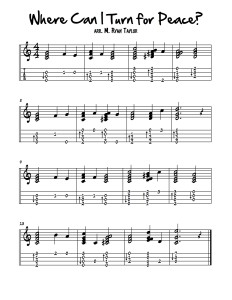 A good friend / former student asked me for some suggestions on solutions to a chord melody version of “Where Can I Turn for Peace?,” a well-known LDS hymn. He was working from the version included on page 30 of Hymns Made Easy (which includes chord indications above the melody). It was easier for me to illustrate by arranging this song than try to explain in an email, so here is my solution:
A good friend / former student asked me for some suggestions on solutions to a chord melody version of “Where Can I Turn for Peace?,” a well-known LDS hymn. He was working from the version included on page 30 of Hymns Made Easy (which includes chord indications above the melody). It was easier for me to illustrate by arranging this song than try to explain in an email, so here is my solution:
Some questions that arise in looking at this tune . . .
What do you do when some of the melody notes do not belong to the chords indicated in the music? This is a common thing in music of all stripes. Melodic notes that do not belong to the chord sequence add tension and interest to the melody. When arranging a chord melody solo you’ll need to incorporate these notes into the fingering, which means you’ll need to be able to find the note on its own in the first place (learn your C-scale to start with). For example, this hymn calls for a B-note over a C-diminished chord on in the third measure. When you change the C to a B in that chord, you end up with a B7 chord instead. You can see this in the arrangement above.
What do you do when a melody note is buried in the middle or bottom of the chord instead of being the top note? Wilfried Welti is a fairly well-known and respected ukulele arranger. I’m borrowing ‘the Welti solution’ to make this arrangement work. His answer lies in how you arpeggiate the chord you are playing. This is indicated by arrows in the arrangement that stop on the melody note you wish to highlight. An up-arrow indicates a motion from string 4 towards string 1, while a down-arrow indicates the opposite direction. You’ll note that where a melody note takes place on one of the inner strings, you stop the arpeggio on that string (see the arrangement above). Using this solution you can highlight any note of a chord.
What do you do when a melody note goes below the range of the ukulele? Lots of vocal melodies go below the C that is the lowest note on the ukulele. A popular solution is to put a low-G string on your uke, but let’s pretend that option doesn’t exist and you don’t want to string your ukulele like a mini-guitar. If we’re not willing to transpose the entire melody up into ukulele range, then we must make do somehow. One solution is to leave those notes out and to the imagination of the listener. Another is to transpose just that phrase of music up an octave. This latter option is what I’ve done at the end of the second line of music in the arrangement above.
Using these three techniques, you can create a lovely and convincing chord-melody arrangement in the ukulele’s lower range without transposing up into the higher fret-range of the instrument. I’ll talk about transposing the melody up to a ‘ukulele-friendly’ key in a future ‘part 2’ article on ukulele chord melody arranging.
Update: Now you can read part 2 on transposing! with an updated version of the arrangement.
Source Files
Get the source files (pdf, finale and music xml for import into other music editors) for the above arrangement under the ‘Files’ tab of the Joyful Noise! LDS Ukulele group on FaceBook. Also, if you’re interested in sharing your arrangements of hymns and Christ-centered spiritual songs, this is a great place to do it.
Gravity : Cover by Jason Arimoto
Rarely do you get great playing and vocals in the same solo cover . . . Just wait til he starts singing!
The Daily Ukulele : To Go!
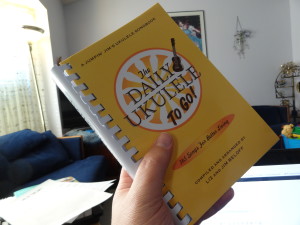 Just in case you didn’t know . . . The Daily Ukulele is now availble in a palm-sized edition. This book is awesome with a great selection of songs, is a standard at many ukulele jams, and now fits in the pocket of your ukulele case!
Just in case you didn’t know . . . The Daily Ukulele is now availble in a palm-sized edition. This book is awesome with a great selection of songs, is a standard at many ukulele jams, and now fits in the pocket of your ukulele case!
The full sized version of this is in my library, marked with about 100 post it notes. Time to start transferring my notes over. 🙂
One minor quibble I have with this, and the original book, is that many of the songs are in keys that are a little low for your average singer. However, if you learn how to transpose songs (and every player should at some point learn how to), then there is ‘no problem.’
Choosing a New Ukulele
I am often asked about choosing a new ukulele and what brand I recommend.
That’s a tough question. My advice always is to go to a store with a huge selection of instruments and try out every one they have. The brand doesn’t so much matter as one brand might have a great ukulele in one model and a hunk of wood with strings on in another. The only way to know is to try them out. Here is a list of things I would check for:
- Intonation: When you pluck an open string and then fret at the 12th fret does it sound like the same note?
- Action: Is the action good near the nut? Are the strings significantly higher off the fret board at the 12th fret? This can be adjusted, but is nice to have it right to start off with. Is the neck straight as an arrow? This can’t be adjusted.
- Tone: Do you like how the instrument sounds all the length of the neck on single notes? Does it sound crisp, balanced or muddy when you play chords? Pluck each string individually all the way up the fretboard and listen for consistency of tone and sustain. Do you note anything buzzing (buzzes may or may not be fixable)?
- Finish: As you feel along the side of the frets do they snag at your fingers or do they feel smooth and allow your fingers to run smoothly down the fret board? Again, this can be sanded down if it is ‘snaggy’ but it shows there isn’t an attention by the maker to details that are important. Check for cracks and stress marks. Do the tuners operate smoothly? Try taking it down a tone and back up again.
- Pick up / on-board electronics (if desired): Have you tested it plugged in and fiddled with any on board EQ to adjust the sound of the instrument? Do you like what your hearing? Do each of the strings pick up equally well? Do you hear ‘bassy thunks’ (this is a bad thing) every time you play an individual string? Have you tried it on a couple of different amps? Also, if you’re investing in an amp, try a few out (the amp can have a big impact on your sound).
Good looks are nice, but the above criteria are what I would look for first.
Thanks to Ian Porter and Todd Fiegel for a couple of additional thoughts that were added to the list above on finish and tone.
Learning Chords: Song by Song Vs. Step by Step
A new post on my Power Up Ukulele site that talks about the benefits of Song by Song and Step by Step learning: http://powerup.ukuleleplay.com/chords-step-by-step-vs-song-by-song-approach/
Twenty One Pilots Ukulele cover of Can’t Help Falling in Love With You
I was wondering why many of my young students were coming in and wanting to sing this classic song (originally from before I was born), but this helps explain it. This is a pretty easy one to learn using ‘level 3’ chords. Dr. Uke offers a song sheet here: http://www.doctoruke.com/canthelpfallinginlove.pdf
Exciting Development in Sustainable Ukuleles : EKoa Tenor
https://www.youtube.com/watch?v=SUbC54jlcHY
The Prettiest Ukes at NAMM 2016
These custom ukuleles by Rebel Ukulele win my award for the prettiest ukes at NAMM 2016:
Analysing a Jawaiian Strum
A student asked me to help with the strum in the body of this cover of Earth Angel:
I’ll admit I used a little known YouTube feature to help me figure out what he was doing; I slowed the video down to half speed and discovered . . . He’s combining left hand muting with chnking in a Jawaiian-style (a mixture of Hawaiian and reggae). It is really advanced, but you can conquer most anything if you break it down, go slowly and have the patience to go over it a thousand times. Here is what he is doing most of the time (with small variations throughout):
ϴ– X– ϴ– –– | ϴ– Xx ΠΦ –– (notice NOTHING is happening on beat four)
where . . .
ϴ = staccato downstroke muted quickly by lifting the left hand or with a ‘pinky mute’
X = chnk (percussive downstroke muted with rh)
x = left hand dead strum or pinky mute
Π = downstroke with index, middle or both
Φ = staccato upstroke muted quickly with right hand (or by lifting the left in case of a barre chord or by ‘pinky mute’) – in this case, either of the latter two options is used
You can simplify this by using Θ (Θ = staccato downstroke muted quickly with rh) in place of ϴ and using the right hand mute option with Φ, but it will sound subtly (or not so subtly) different, depending on many factors.
Find out more about strumming shorthand at <a href=”http://powerup.ukuleleplay.com/strumming/key-strum-shorthand/” target=”_blank”>http://powerup.ukuleleplay.com/strumming/key-strum-shorthand/</a>
Ukulele Christmas : Projector Collection
- Ukulele Christmas : Projector Collection on Teachers Pay Teachers
Some of the best tunes from The Two Chord Christmas Songbook and Christmas on 34th Street, now formatted for projectors and smartboards with group ukulele jams and classrooms in mind. Landscape formatted PDF files include . . .
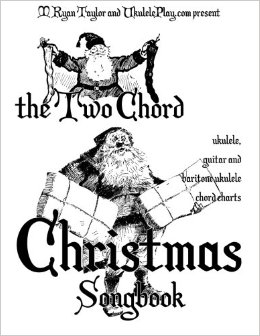 Away in a Manger
Away in a Manger
Behold that Star
Bring a Torch
Christ Was Born on Christmas Day
Christmas is Coming
Coventry Carol
Deck the Hall
Ding Dong! Merrily on High!
Go Tell it on the Mountain
Good Christian Men, Rejoice!
Good King Wenceslaus
He is Born
Here We Come A-Wassailing
Hey, Ho, Nobody Home
I Saw Three Ships
Infant Holy, Infant Lowly
Jingle Bells
Jolly Old St. Nicholas
Joy to the World
Mary Had a Baby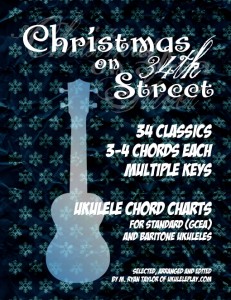
O Christmas Tree
O Little Town of Bethlehem
Oh Come All Ye Faithful
Once in Royal David’s City
Patapan
Silent Night
Sleep of the Child Jesus
Still, Still, Still
The First Noel
The Friendly Beasts
The Holly and the Ivy
Up on the Housetop
Wassail, Wassail, All Over the Town!
We Wish You a Merry Christmas
Wexford Carol
What Child is This?
What Shall We Give?
Titan M’s 2 Chord Companion : 157 songs in Ukulele-Friendly Keys
Get the 2 Chord Companion at . . .
Author’s Note:
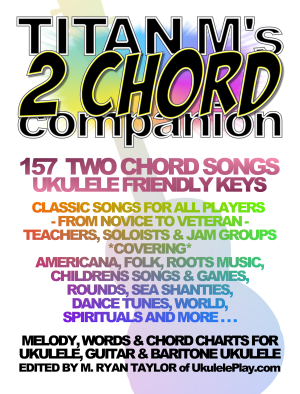 What kind of obsessive-compulsive person catalogs over 400 two-chord songs, then carefully selects the cream of the crop and painstakingly typesets 157 of them to publish in a single volume? That would be me, a self-proclaimed music nerd and ukulele enthusiast.
What kind of obsessive-compulsive person catalogs over 400 two-chord songs, then carefully selects the cream of the crop and painstakingly typesets 157 of them to publish in a single volume? That would be me, a self-proclaimed music nerd and ukulele enthusiast.
Why would I spend months doing such a thing? I spend a lot of time teaching people to play the ukulele, and two-chord songs are great for a lot of things:
- Introducing basic chord pairs
- Hammering the transition between those pairs
- Teaching chord relationships
- Training the ear to hear these relationships
- Gaining practice in transposing songs
- A feeling of accomplishment for beginners
- A jumping off point for intermediate players to begin embellishing chords
- A blank slate for advanced players to begin working on chord substitutions and arranging
- A safe place for players of all levels to jam
So, whether you’re new to the uke or a veteran player, this book is for you. I hope you’ll visit http://j.mp/UkulelePlayYouTube and subscribe to follow along as I explore many of these wonderful songs and some of the various things you can do with them.
Enjoy!
TITAN M
a.k.a. M. Ryan Taylor
Contents : By Topic
AMERICANA & HISTORICAL
Bought me a Cat
Bound for the Promised Land
Buffalo Gals
Chickalileo
Cotton Eye Joe
Darling Cory
Doodle Dandy
Down in the Valley
Freedom Train
Hymn for Nations
I’ll Sell My Hat
I’m Gonna Sing
In Wisdom’s Lovely
Pleasant Ways
Jerry
John Henry
Little Birdie
Mary Ann
No More, My Lord
Old Joe Clark
Old Stewball
Polly Wolly Doodle
Rockin’ By the Baby
Rocky Mountain
Santy Anno
Shady Grove
Shortnin’ Bread
Simple Gifts
Sinner Man
Skip to my Lou
Springfield Mountain
Streets of Laredo, The
Sweet Betsy from Pike
Tom Dooley
Train’s Off the Track
Ut Queant Laxis
Welcome Here
Wondrous Love
Yellow Rose of Texas, The
AROUND THE WORLD
Arirang
Day-O (Banana Boat Song)
Four White Horses
Land of the Silver Birch
Lukey’s Boat
Mary Ann
My Paddle’s Keen and Bright
Ode to Joy
Shalom Chaverim
She Moved Through the Fair
Shoheen Sho
Sosban Fach : Little Pot
Stewball
Sweet Molly Malone
Wild Mountain Thyme, The
LOVERS
Are Ye Sleeping Maggie?
Arirang
Black is the Color
Buffalo Gals
Clementine
Cocky Robin
Cotton Eye Joe
Darling Cory
Down in the Valley
Green Bushes
I’ll Sell My Hat
Johnny Has Gone for a Soldier
Little Birdie
Long, Long Ago
Love Somebody
Love will Find Out a Way
My Bonny Boy
My Horses Ain’t Hungry
Pretty Little Miss
Reuban and Rachel
Shady Grove
She Moved Through the Fair
Sweet Betsy from Pike
Time I’ve Lost in Wooing, The
Train’s Off the Track
Walking on the Green Grass
Water is Wide, The
Wild Mountain Thyme, The
Yellow Rose of Texas, The
CHILDREN
Ah, Poor Bird
Black Socks
Bluebird, Bluebird
Bought me a Cat
Bow Belinda
By’m Bye
Chickalileo
Cocky Robin
Down by the Station
Fair Rosa
Farmer in the Dell, The
Fire Engines
Four White Horses
Ghost of John, The
Go Tell Aunt Rhody
Grand Old Duke of York, The
I Went to the Pictures Tomorrow
I’m Gonna Sing
Itsy Bitsy Spider
I’ve Been to Harlem
I’ve Got a Car, It’s Made of Tin
Land of the Silver Birch
Little Johnny Brown
London Bridge
Love Somebody
Mactavish is Dead
Mamalama
Maria’s Gone
Mary Had a Little Lamb
More We Get Together, The
My Aunt Came Back
My Paddle’s Keen and Bright
My Zuzette
Oats and Beans
Old, Old Shack
One, Two, Three Alairy
Peter Rabbit
Poor Little Kitty Cat
Reuban and Rachel
Rosy Apple, Lemon and a Pear
Samba Lele
Skim, Skim, Skim
Skin and Bones
Sosban Fach : Little Pot
Sweet Potatoes
Telephone Song, The
Ten Little Indians
Throw it Out the Window
Where, Oh Where Has
My Little Dog Gone?
Who Did Swallow Jonah?
Who’s That?
EERIE & MORBID
Ah, Poor Bird
Are Ye Sleeping Maggie?
Bury Me Not on the Lone Prairie
Clementine
Cocky Robin
Darling Cory
Ghost of John, The
Go Tell Aunt Rhody
Jerry
Mactavish is Dead
Mary Golden Tree, The
She Moved Through the Fair
Sinner Man
Skin and Bones
Sometimes I Feel Like
a Motherless Child
Springfield Mountain
Streets of Laredo, The
Sweet Molly Malone
Three Blind Mice
Tom Dooley
Walking on the Green Grass
SPIRITUALS & HYMNS
A Poor Wayfaring Man of Grief
Bound for the Promised Land
By an’ By
Go Down Moses
Good News
He’s Got the Whole World
Hymn for Nations
I’m Gonna Sing
In Wisdom’s Lovely
Pleasant Ways
Jacob’s Ladder
Joshua Fought
the Battle of Jericho
Joyful, Joyful, We Adore Thee
Let me Fly
Mary and Martha
No More, My Lord
Nobody Knows
the Trouble I’ve Seen
Ode to Joy
Oh, Mary Don’t You Weep
Old Arks’s A-Moverin’
Palms of Victory
Rock of Ages
Rock-a My Soul
Simple Gifts
Sinner Man
Sometimes I Feel Like
a Motherless Child
Trampin’
Ut Queant Laxis
Wade in the Water
When the Train Comes Along
Wondrous Love
NONSENSE
Black Socks
Buffalo Gals
Clementine
Cotton Eye Joe
Grand Old Duke of York, The
Haul on the Bowlin’
Hurrah for the Cook
I Went to the Pictures Tomorrow
I’ll Sell My Hat
I’ve Got a Car, It’s Made of Tin
Love Somebody
Lukey’s Boat
Mary Ann
More We Get Together, The
Old Joe Clark
Old, Old Shack
One, Two, Three Alairy
Polly Wolly Doodle
Pretty Little Miss
Reuban and Rachel
Rockin’ By the Baby
Samba Lele
Shortnin’ Bread
Skip to my Lou
Sosban Fach : Little Pot
Sweet Betsy from Pike
There was an Old Fellow
Throw it Out the Window
Time I’ve Lost in Wooing, The
Who Did Swallow Jonah?
ROUNDS
Ah, Poor Bird
Down by the Station
Freedom Train
Here’s a Health
Kaeru No Uta (Frog Song)
Kookabura
List to the Bells
Little Tom Tinker
Make New Friends
My Paddle’s Keen and Bright
Oh, How Lovely is the Evening
One May Begin
Orchestra, The
Row, Row, Row Your Boat
Shalom Chaverim
Sing, Sing Together
There was an Old Fellow
Three Blind Mice
We Thank Thee for Our Daily Bread
GAMES & DANCES
Bluebird, Bluebird
Bow Belinda
Chickalileo
Cocky Robin
Fair Rosa
Farmer in the Dell, The
Four White Horses
Little Johnny Brown
London Bridge
Mamalama
Maria’s Gone
My Aunt Came Back
Old Joe Clark
One, Two, Three Alairy
Peter Rabbit
Poor Little Kitty Cat
Pretty Little Miss
Rocky Mountain
Rosy Apple, Lemon and a Pear
Samba Lele
Shady Grove
Skim, Skim, Skim
Skip to my Lou
Telephone Song, The
Walking on the Green Grass
LULLABYS
Hush Little Baby
Hushabye, Don’t You Cry
Rockin’ By the Baby
Shoheen Sho
OCEAN BLUE
Drunken Sailor
Haul on the Bowlin’
Hurrah for the Cook
I’ve Been to Harlem
John Kanaka
Lukey’s Boat
Mary Ann
Mary Golden Tree, The
Pay me my Money Down
Santy Anno
Spanish Ladies
COWBOYS
Bury Me Not on the Lone Prairie
Doney Gal
I Ride an Old Paint
My Horses Ain’t Hungry
Old Chisholm Trail, The
Railroad Corral, The
Streets of Laredo, The
256 Basic Strum Patterns!
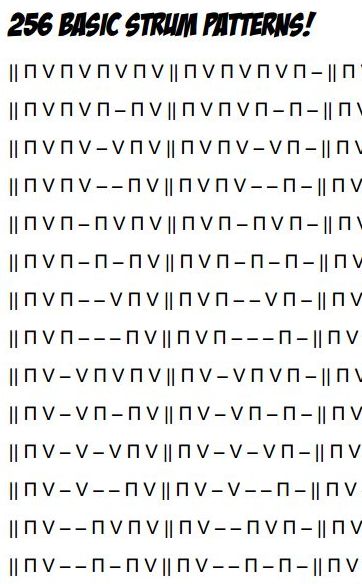 As I was working on the Level 1 Strumming section of the Power Up Ukulele site/syllabus, I got curious as to how many combinations of basic ‘down up’ strums are possible in a measure of 4/4. How useful some of these strums may or may not be is up to you to decide, but I’ve already seen a couple that might warrant a closer look.
As I was working on the Level 1 Strumming section of the Power Up Ukulele site/syllabus, I got curious as to how many combinations of basic ‘down up’ strums are possible in a measure of 4/4. How useful some of these strums may or may not be is up to you to decide, but I’ve already seen a couple that might warrant a closer look.
To get my number of 256, I limited the possibilities by removing thumb strums and assuming that upstrums will happen only on the ‘and’ or second half of a beat. That leaves us with Π V, Π –, – V & – – as possible beats (dashes represent periods where there’s silence or we’re letting the ukulele ring). I entered these into a ‘permutation calculator’ and had it generate the results. Enjoy!
|| Π V Π V Π V Π V ||
|| Π V Π V Π V Π – ||
|| Π V Π V Π V – V ||
|| Π V Π V Π V – – ||
|| Π V Π V Π – Π V || Π V Π V Π – Π – || Π V Π V Π – – V || Π V Π V Π – – – ||
|| Π V Π V – V Π V || Π V Π V – V Π – || Π V Π V – V – V || Π V Π V – V – – ||
|| Π V Π V – – Π V || Π V Π V – – Π – || Π V Π V – – – V || Π V Π V – – – – ||
|| Π V Π – Π V Π V || Π V Π – Π V Π – || Π V Π – Π V – V || Π V Π – Π V – – ||
|| Π V Π – Π – Π V || Π V Π – Π – Π – || Π V Π – Π – – V || Π V Π – Π – – – ||
|| Π V Π – – V Π V || Π V Π – – V Π – || Π V Π – – V – V || Π V Π – – V – – ||
|| Π V Π – – – Π V || Π V Π – – – Π – || Π V Π – – – – V || Π V Π – – – – – ||
|| Π V – V Π V Π V || Π V – V Π V Π – || Π V – V Π V – V || Π V – V Π V – – ||
|| Π V – V Π – Π V || Π V – V Π – Π – || Π V – V Π – – V || Π V – V Π – – – ||
|| Π V – V – V Π V || Π V – V – V Π – || Π V – V – V – V || Π V – V – V – – ||
|| Π V – V – – Π V || Π V – V – – Π – || Π V – V – – – V || Π V – V – – – – ||
|| Π V – – Π V Π V || Π V – – Π V Π – || Π V – – Π V – V || Π V – – Π V – – ||
|| Π V – – Π – Π V || Π V – – Π – Π – || Π V – – Π – – V || Π V – – Π – – – ||
|| Π V – – – V Π V || Π V – – – V Π – || Π V – – – V – V || Π V – – – V – – ||
|| Π V – – – – Π V || Π V – – – – Π – || Π V – – – – – V || Π V – – – – – – ||
|| Π – Π V Π V Π V || Π – Π V Π V Π – || Π – Π V Π V – V || Π – Π V Π V – – ||
|| Π – Π V Π – Π V || Π – Π V Π – Π – || Π – Π V Π – – V || Π – Π V Π – – – ||
|| Π – Π V – V Π V || Π – Π V – V Π – || Π – Π V – V – V || Π – Π V – V – – ||
|| Π – Π V – – Π V || Π – Π V – – Π – || Π – Π V – – – V || Π – Π V – – – – ||
|| Π – Π – Π V Π V || Π – Π – Π V Π – || Π – Π – Π V – V || Π – Π – Π V – – ||
|| Π – Π – Π – Π V || Π – Π – Π – Π – || Π – Π – Π – – V || Π – Π – Π – – – ||
|| Π – Π – – V Π V || Π – Π – – V Π – || Π – Π – – V – V || Π – Π – – V – – ||
|| Π – Π – – – Π V || Π – Π – – – Π – || Π – Π – – – – V || Π – Π – – – – –||
|| Π – – V Π V Π V || Π – – V Π V Π – || Π – – V Π V – V || Π – – V Π V – – ||
|| Π – – V Π – Π V || Π – – V Π – Π – || Π – – V Π – – V || Π – – V Π – – – ||
|| Π – – V – V Π V || Π – – V – V Π – || Π – – V – V – V || Π – – V – V – – ||
|| Π – – V – – Π V || Π – – V – – Π – || Π – – V – – – V || Π – – V – – – – ||
|| Π – – – Π V Π V || Π – – – Π V Π – || Π – – – Π V – V || Π – – – Π V – – ||
|| Π – – – Π – Π V || Π – – – Π – Π – || Π – – – Π – – V || Π – – – Π – – – ||
|| Π – – – – V Π V || Π – – – – V Π – || Π – – – – V – V || Π – – – – V – – ||
|| Π – – – – – Π V || Π – – – – – Π – || Π – – – – – – V || Π – – – – – – – ||
|| – V Π V Π V Π V || – V Π V Π V Π – || – V Π V Π V – V || – V Π V Π V – – ||
|| – V Π V Π – Π V || – V Π V Π – Π – || – V Π V Π – – V || – V Π V Π – – – ||
|| – V Π V – V Π V || – V Π V – V Π – || – V Π V – V – V || – V Π V – V – – ||
|| – V Π V – – Π V || – V Π V – – Π – || – V Π V – – – V || – V Π V – – – – ||
|| – V Π – Π V Π V || – V Π – Π V Π – || – V Π – Π V – V || – V Π – Π V – – ||
|| – V Π – Π – Π V || – V Π – Π – Π – || – V Π – Π – – V || – V Π – Π – – – ||
|| – V Π – – V Π V || – V Π – – V Π – || – V Π – – V – V || – V Π – – V – – ||
|| – V Π – – – Π V || – V Π – – – Π – || – V Π – – – – V || – V Π – – – – – ||
|| – V – V Π V Π V || – V – V Π V Π – || – V – V Π V – V || – V – V Π V – – ||
|| – V – V Π – Π V || – V – V Π – Π – || – V – V Π – – V || – V – V Π – – – ||
|| – V – V – V Π V || – V – V – V Π – || – V – V – V – V || – V – V – V – – ||
|| – V – V – – Π V || – V – V – – Π – || – V – V – – – V || – V – V – – – – ||
|| – V – – Π V Π V || – V – – Π V Π – || – V – – Π V – V || – V – – Π V – – ||
|| – V – – Π – Π V || – V – – Π – Π – || – V – – Π – – V || – V – – Π – – – ||
|| – V – – – V Π V || – V – – – V Π – || – V – – – V – V || – V – – – V – – ||
|| – V – – – – Π V || – V – – – – Π – || – V – – – – – V || – V – – – – – – ||
|| – – Π V Π V Π V || – – Π V Π V Π – || – – Π V Π V – V || – – Π V Π V – – ||
|| – – Π V Π – Π V || – – Π V Π – Π – || – – Π V Π – – V || – – Π V Π – – – ||
|| – – Π V – V Π V || – – Π V – V Π – || – – Π V – V – V || – – Π V – V – – ||
|| – – Π V – – Π V || – – Π V – – Π – || – – Π V – – – V || – – Π V – – – – ||
|| – – Π – Π V Π V || – – Π – Π V Π – || – – Π – Π V – V || – – Π – Π V – – ||
|| – – Π – Π – Π V || – – Π – Π – Π – || – – Π – Π – – V || – – Π – Π – – – ||
|| – – Π – – V Π V || – – Π – – V Π – || – – Π – – V – V || – – Π – – V – – ||
|| – – Π – – – Π V || – – Π – – – Π – || – – Π – – – – V || – – Π – – – – – ||
|| – – – V Π V Π V || – – – V Π V Π – || – – – V Π V – V || – – – V Π V – – ||
|| – – – V Π – Π V || – – – V Π – Π – || – – – V Π – – V || – – – V Π – – – ||
|| – – – V – V Π V || – – – V – V Π – || – – – V – V – V || – – – V – V – – ||
|| – – – V – – Π V || – – – V – – Π – || – – – V – – – V || – – – V – – – – ||
|| – – – – Π V Π V || – – – – Π V Π – || – – – – Π V – V || – – – – Π V – – ||
|| – – – – Π – Π V || – – – – Π – Π – || – – – – Π – – V || – – – – Π – – – ||
|| – – – – – V Π V || – – – – – V Π – || – – – – – V – V || – – – – – V – – ||
|| – – – – – – Π V || – – – – – – Π – || – – – – – – – V || – – – – – – – – ||
Christmas Carols for Ukulele Orchesta now on Amazon
AND . . . it is already the #1 bestseller in New Releases for Ukulele Songbooks, and I haven’t even started promoting it. Check out Christmas Carols for Ukulele Orchestra on Amazon and be the first to leave a review!
More new demos for The Haunted Ukulele
I recorded 5 more demos yesterday for my new book, The Haunted Ukulele:
- Halloween Carnival (an original!)
- The Haunted House (by Irving Berlin!)
- The Happy Cow Song (another original!)
- Hangman (my parody for kids on Tom Dooley)
- Old Roger (a circle game for kids from Great Britain)
Enjoy the entire Haunted Ukulele Playlist:
https://www.youtube.com/watch?v=W1t1yuVOyhs&list=PLa626nR993OwrlUuS_ssyWl5mYsp8DTyH
6 New Haunted Ukulele Demo Videos
I finished 6 new demo videos for The Haunted Ukulele today (for a total of 39 of the 59 songs in the book):
I’ve added these to the playlist:
http://youtu.be/W1t1yuVOyhs?list=PLa626nR993OwrlUuS_ssyWl5mYsp8DTyH
Chopsticks Tab for Ukulele
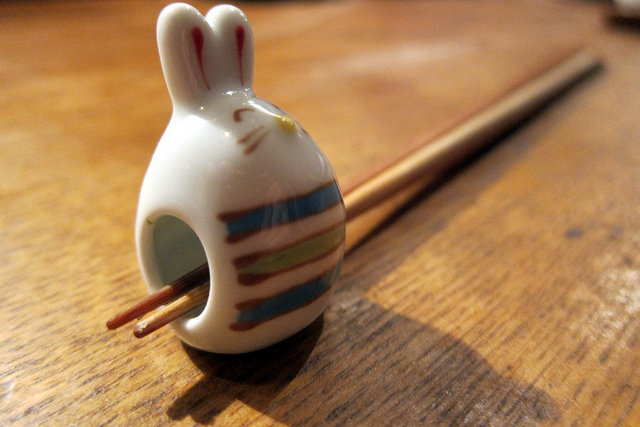 I was noodling around on my uke a few weeks ago when something started to sound familiar, “That’s Chopsticks.” So I took a few minutes and figured out the rest of the piece. The A-section is really easy and the B-section is a really great exercise for various double-stops (which I’ve included 2 different ways).
I was noodling around on my uke a few weeks ago when something started to sound familiar, “That’s Chopsticks.” So I took a few minutes and figured out the rest of the piece. The A-section is really easy and the B-section is a really great exercise for various double-stops (which I’ve included 2 different ways).
So here you go, the celebrated chopstick waltz:
- Chopsticks (PDF)
Enjoy!
HI*Sessions : Learning from the Best
I often suggest to my students that they watch the great uke players as well as listen to them. You can learn a lot just by watching. One of the great places to do this is HI*Sessions, a youtube channel that occasionally features some of the greatest ukulele players of our day, all in up-close-and-personal hi-def. Here are the episodes featuring some of my favorite players (you can skip the intros with the little navigation arrows at the bottom of the player) . . .
Kalei Gamiao
James Hill
Aldrine
Herb Ohta Jr.
Brittni
Taimane
Review: Ukulele Duets
 Ukulele Duets, released by Mel Bay.
Ukulele Duets, released by Mel Bay.
As a blogger and an ukulele book author, I generally try to be as kind and positive as I can about any ukulele book I come across. I try to imagine who would enjoy the book, rather than whether I would find it personally useful.
I had great hopes for this book. I teach ukulele groups and a book of duets would be a wonderful resource. The formatting is nice and clean; it includes melody and tab lines for each of the ukuleles.
Problems started to arise though, when I played through the book. One ukulele plays through the melody, which is no surprise. Where I was dissapointed, and frankly think makes this book useless, is that the harmony part on the second uke is almost entirely, in every arrangement, a parallel third or fourth above the melody. Anyone could figure out how to play in parallels. Who needs a whole book for it?
In short, there is no real arranging here, just a formula used over and over again. The ears get tired of this kind of thing really quick. For this book to be useful, I would expect to some good/interesting counterpoint.
Thankfully, Amazon refunded my purchase.
Review: Cowboy Songs for Ukulele
 Cowboy Songs for Ukulele from Hal Leonard includes a nice selection of tunes from the classic days of cowboy songs, before cowboy turned into country; think Gene Autrey, Johnny Cash, Roy Rogers and various cowboy folk songs. Some songs I might work up myself include Back in the Saddle, Ghost Riders in the Sky, Happy Trails, and various of the Gene Autrey songs that are included.
Cowboy Songs for Ukulele from Hal Leonard includes a nice selection of tunes from the classic days of cowboy songs, before cowboy turned into country; think Gene Autrey, Johnny Cash, Roy Rogers and various cowboy folk songs. Some songs I might work up myself include Back in the Saddle, Ghost Riders in the Sky, Happy Trails, and various of the Gene Autrey songs that are included.
Who this book is for:
- Folks that love cowboy tropes and songs; these are full of wonderful cliches about trails, cowgirls, gunfights and more.
- Folks that prefer a chords-over-melody-line-and-lyrics format (like The Daily Ukulele). I enjoy having a melody line to help learn unfamiliar songs without having to look up a recording.
- Folks that are comfortable improvising/making up their own strum/fingerpicking patterns on the fly.
Also worthy of note, the chord level in this book is fairly easy, making it a great selection for groups with mixed levels of players or advancing beginners.
Review: Two-Chord Songs (Guitar Chord Songbook)
 Two-Chord Songs (Guitar Chord Songbook) by Hal Leonard has an eclectic mix of rock, pop and country songs that I’m excited to explore more. Some songs I am familiar with (Paperback Writer, ABC, Day-O, etc.), and others I’m going to have to get on youtube or spotify and look up, but with these easy resources for learning the melodies of songs freely available, I’m just not too worried that there are songs I don’t know in the collection.
Two-Chord Songs (Guitar Chord Songbook) by Hal Leonard has an eclectic mix of rock, pop and country songs that I’m excited to explore more. Some songs I am familiar with (Paperback Writer, ABC, Day-O, etc.), and others I’m going to have to get on youtube or spotify and look up, but with these easy resources for learning the melodies of songs freely available, I’m just not too worried that there are songs I don’t know in the collection.
Although I was a little puzzled when Hal Leornard sent me a guitar book for review, it doesn’t take much imagination or skill to turn ANY songbook with chords into an ukulele songbook; all you need is a ukulele chord reference (chart, dictionary or online app) and the patience to look up the chords and write them into the music. Actually, you don’t even need much patience when it comes to songs that only have two chords!
As a teacher, I love two chord songs (yep, I’ve even published two songbooks dedicated to them). When practicing transitions between chords, I find it best to focus on two chords at a time and two chord songs offer almost instant gratification to the student as a reward for their dilligence.
So, if you’re a beginner, or just like it easy, consider ignoring the guitar on the cover of this book and picking up a copy to add to your ukulele songbook collection. You might also consider picking up the Hal Leonard Ukulele Chord Finder: Easy-to-Use Guide to Over 1,000 Ukulele Chords for less than six bucks to make writing in your ukulele chord symbols a snap (I use this book all the time).
Review: The Best Songs Ever (Ukulele Chord Songbook)
 The Best Songs Ever (Ukulele Chord Songbook) from Hal Leonard is an interesting selection of songs in the chords-over-lyrics format many ukers are accustomed to.
The Best Songs Ever (Ukulele Chord Songbook) from Hal Leonard is an interesting selection of songs in the chords-over-lyrics format many ukers are accustomed to.
Who this book is for:
- Players of a certain age to whom these songs are familiar. I’m in my early forties and hadn’t heard of many of the songs in this book (maybe half). However, my mother flipped through this book and knew almost every song (she’s in her early seventies).
- Players who want the songs in the original keys and are not afraid of learning large sets of (sometimes difficult) chords. Many songs feature over 20 chords.
- Players who prefer the chords-over-lyrics format and don’t want to be bothered with treble cleff, notes, or tabs.
If you fit the above profile, this book may be a good addition to your library.
I was sent a review copy of this book from Hal Leonard.
Review: Ukulele Aerobics by Chad Johnson
This is a review of Ukulele Aerobics: For All Levels, from Beginner to Advanced by Chad Johnson that I posted on Amazon . . .
Who this book is NOT for: Beginners. The only reason this book got a one-star rating from someone is that it is marketed as an ‘ALL LEVELS’ book, which I consider false advertising (which is why I see it as a four star book). I can say this with some confidence because I’ve taught hundreds of beginning students to play the ukulele and this book would leave most of them in the dust, discouraged and disheartened. Also, this book is NOT for people who prefer to learn the ukulele organically . . . by which I mean ‘one song at a time’ (the book includes drills for skills in seven categories, there are no songs in this book). Despite these drawbacks . . . this is an awesome book.
Who this book IS for: players with a firm grasp of the basics, that have a good number of chords already under their belt, have good practicing skills, aren’t afraid of standard staff notation and are glad to see it side by side with tablature. If this is you, you’re going to get a lot out of this book.
That said, I consider myself an intermediate player with a lot of musical knowledge that translates over from other instruments I’ve learned to play. Even with that kind of background, there’s some pretty tough stuff in this book that you’re going to have to be patient with . . .
The toughest part may be the advanced/tricky chord shapes that are thrown out pretty early in the book (I have a hard time understanding the rhyme/reason for the order in which chords are introduced). But, if you’re like me, you’ll enjoy stretching yourself a bit to make your fingers fit these shapes.
I like what one of the other reviewers said about using each week as a daily round of seven drills. I think people will get a lot more out of the book practicing this way as some of the drills are not going to be mastered in a day.
WHAT I LOVE: There’s stuff in this book I haven’t seen anywhere else, and I’ve bought about twenty instructional ukulele books in my quest to be a better teacher. Also, as a singer/songwriter, it is so nice to be able to pick up new techniques, fingerpicking, strumming, chords, riffs to inspire my own writing.
Ukulele Aerobics can be found on Amazon (link above) or on Hal Leonard’s website: http://www.halleonard.com/product/viewproduct.do?itemid=102162
How should I practice? : 3 Top Tips for Making Fast Progress
 I’ve thought a lot about this quote, attributed to the great pianist Bill Evans, “It’s better to practice one song for 24 hours than play 24 tunes in one hour.”
I’ve thought a lot about this quote, attributed to the great pianist Bill Evans, “It’s better to practice one song for 24 hours than play 24 tunes in one hour.”
By nature, I’m a 24-tune-an-hour kind of guy. I love variety. I love playing through songs. That said, I know there is a better way to practice and make progress. Here are my three top tips for making quick progress on your instrument.
1. Slow is Fast
Everyone wants to play a song up to tempo, even at the beginning. The problem is, we experience time in a very relative way. When things are easy, our timing is pretty spot on, but when things get tough, time seems to warp and we slow down. Sometimes, we don’t even realize we’re slowing down. If you want to test this, try playing a song that has some easy spots and some tough spots and then turn on a metronome and see what happens.
Because of this ‘time warp’ effect in our brains, people often lumber on through the difficult stretches without stopping, usually not realizing that they’ve slowed way down, only to speed up again when the going gets easy. This really messes with our sense of timing, which in itself is an important musical skill that must be developed.
The solution to this problem is to slow down and . . .
2. Put the Tough Spots on Loop
Forget about starting at the beginning every time. You know where the tough spots are in that song you’re practicing. Isolate a difficult passage of the music and put it on loop. Repeat that section slowly, over and over. It may only be a little twiddly-bit or lick, or it may be a full measure or two, or it may be a longer phrase. Isolate it and loop it . . . over and over and over again.
3. Practice with Someone (or Something)
Make sure you’re being honest with yourself. Practice with a metronome and keep looping those tough passages in a slow time. Then, as you feel more comforatable, raise the tempo, little by little until you’ve mastered the passage. Then, merge the passage back into the song. When you’ve got it to your satisfaction and feel you can’t make a mistake (or can’t take it anymore – in which case you can come back to it later), move on to the next difficult section and repeat the process.
One of the reasons I enjoy leading and practicing with my ukulele group, UFO HUM, is that it forces me to do this process with real people which are a lot more fun than metronomes. Alternatively, you can always use drum loops or recording of songs to practice with. The problem in these is controlling the tempo and slowing them down (though there is software for this, its too much trouble for me).
Conclusion
That’s the process I’ve found most helpful making real progress with my instrument: slow down, loop tough passages and use a metronome (or group) to make sure you’re being honest in your timing.
What practicing tips have you found useful? Please comment!
_______
Want more tips? Visit NPR’s 10 Easy Ways to Optimize Your Music Practice.
Review: The Ukulele Toolbox DVD 1
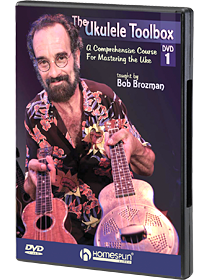 Here is my review and notes from The Ukulele Toolbox DVD 1 released by Homespun Video.
Here is my review and notes from The Ukulele Toolbox DVD 1 released by Homespun Video.
General observations: Over 2hrs of instruction from the late Bob Brozman. The video has a stream of consciousness, conversational tone. The presentation jumps quickly from concept to concept. Be prepared to pause and run back. If I was just starting out, and new little about music, this video would probably overwhelm me. As an intermediate player, I found much that was interesting for me to work on. One of the nice bonuses you should be aware of is that the DVD has a PDF with all the exercises and concepts Bob introduces for you to print off.
Notes
Tuning the Ukulele (GCEA) and issues
- Guitar tuning issues are magnified because of the smaller scale of the uke.
- Use an electronic tuner, but double check the instrument against itself.
- Practical information on adjusting the nut.
- Fine tune “1 to 1 ratio” peg head tuners with a “Pinto Bean Fine Tuner.”
Right Hand Rhythm
- Brain runs many different ‘software programs’ at the same time, so divide and conquer.
- Whole arm stroke . . . down with thumb and up with first finger.
- Swung rhythm vs Straight rhythm.
- Cutting off notes (muting): professional controls where the notes end. Mute with the fleshy side of the palm.
- Strums with thumb and index, index alone and middle finger alone.
- Triplet: down middle, up index, up middle.
- Practice slow and deliberately at first, but as you speed up be lighter with less effort.
- Use the fingerboard as a landing pad for strumming.
- Trying triplets on various beats of the measure.
- All about cutting, pasting and reassembling these little ideas.
- Four finger roll and four finger roll followed by the thumb (calls it a scroll).
- Arranging the landscape of your songs: aggressive, soft, etc.
- Triplet 2 (whole arm triplet): DOWN up down UP down up DOWN up down UP down up.
- 4 2 3 1 (string numbers) fingerpicking with the thumb and index.
- Fingerpicking partial chords with triplet accents.
- Left hand finger placement for partial chords (6ths).
- Blues turnaround.
- Importance of getting variety, cutting and pasting.
- Pinching strings 4 & 2 and 3 & 1.
- Strumming across different parts of the strings changes tone and accent.
- Use the first part of your practice to focus on right hand rhythm and challenge yourself to come up with interesting variations.
The Key of C
- String science, the Greeks, harmonics and home base.
- Scales all made up of combinations of whole steps and half steps.
- The C scale.
- C and G7 chords.
- Think ahead on chord changes.
- Incorporating melodies into chord positions.
- Cadential G7 (0535).
- Alternate F (2013).
- Fingerpicking 4 2 1 3 2 1 3 2
- Fingerpicking 4 2 1 3 2 1
- Many songs use just C, G7 and F.
- Chapter 15: Putting together a blues progression. C, C7, F (and F7), and G7 plus closing turnaround.
- Embellished turnarounds and alternate chord voicings.
- Playing C, G7 and F with the 2-4th fingers to prepare for barre chords.
- Getting more leverage for barre chords.
- Relationships of chords (1, 4, 5) vs. Names of chords (C, F, G7).
- Partial chords can suggest the chord you intend.
- Some chord theory on 9ths, etc.
- Basic ‘Slants’ (partial chords) on middle strings: 00 21 43 55 77 98, etc.
The Key of G
- 1, 4 & 5 = G, C & D7.
- Alternate C voicing.
- Short and long slants in the key of G on strings 1 & 2.
- Key of F = F, Bb & C7.
- Cycle of Fifths (Circle of Fifths) and dominant chords as questions: D7, G7, C7, F.
- Practicing more difficult chord shapes.
- Chord progression Bb, Bbm, F, D7, G7, C7, F. Ending Bb, Bbm, F.
Adding Minors
- Taking that chord progression back to C: F, Fm, C, A7, D7, G7, C.
- Major keys and their relative minors.
- A minor: Am, Dm, E7.
- Adding slaps to your strum patterns.
- 4 inversions for most chords.
- D minor: Dm, Gm, A7 (A dim).
- Chapter 31: 16 bar Calypso in Am: Am, Am, E7, Am, repeat, A7, Dm, G7, C, A7, Dm, E7, Am.
- Relative major Calypso progression.
- Sliding fully closed chords from underneath by one fret for swingtime numbers.
- 32 Bar Form: AABA. Examples with two kinds of bridges.
I Love a Ukulele
- Song tutorial.
Winning Video for UU Christmas on 34th Street Video Contest
I held a much under-promoted (I got really sick just after starting the contest) Christmas Video Contest on Ukulele Underground (link takes you to the thread on their forum where you can see all the entries). Despite the fact I didn’t get the word out like I’d like to have, there were still some great entries from the UU community and here is the winner:
Congratulations to Mina (who wins an Outdoor Ukulele) and thank you to everyone! Merry Christmas!

